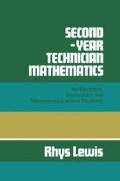Abstract
In engineering and mathematics, physical quantities are those that can be measured in one way or another and the measurement used to compare one quantity with another like quantity. For example, mass is a physical quantity and the amount of matter in one mass can be measured and compared with the amount of matter in another mass. Thus we can say that a 10 kg mass, for example, has twice the amount of matter of a 5 kg mass. Similarly time is a physical quantity and a period of time of, say, 3 hours is three times as long as a period of time of 1 hour. Other physical quantities include length, velocity, acceleration, force, work, energy, power, voltage, electric current, and so on. With many physical quantities the only measurable characteristic is their magnitude or size. Such quantities, for example, mass, length, area, etc., are called scalar quantities. Other quantities have associated with them not only magnitude but also a physical direction in space. These quantities, which include force and velocity, are called vector quantities. A third group of quantities contains those that not only have magnitude but are also time varying, that is, their magnitude varies regularly or otherwise with time. These quantities-which include alternating voltages, currents and the electric and magnetic fields set up by such alternating voltages and currents-are called phasor quantities. In determining the sum or difference of two quantities or when performing other arithmetical processes such as multiplication or division care must be taken to first establish whether the quantities are scalar, vector, or phasor.
Preview
Unable to display preview. Download preview PDF.
Author information
Authors and Affiliations
Copyright information
© 1975 Rhys Lewis
About this chapter
Cite this chapter
Lewis, R. (1975). Vectors and Phasors. In: Second-year Technician Mathematics for Electrical, Electronics and Telecommunications Students. Palgrave, London. https://doi.org/10.1007/978-1-349-02487-2_6
Download citation
DOI: https://doi.org/10.1007/978-1-349-02487-2_6
Publisher Name: Palgrave, London
Print ISBN: 978-0-333-17846-1
Online ISBN: 978-1-349-02487-2
eBook Packages: EngineeringEngineering (R0)

